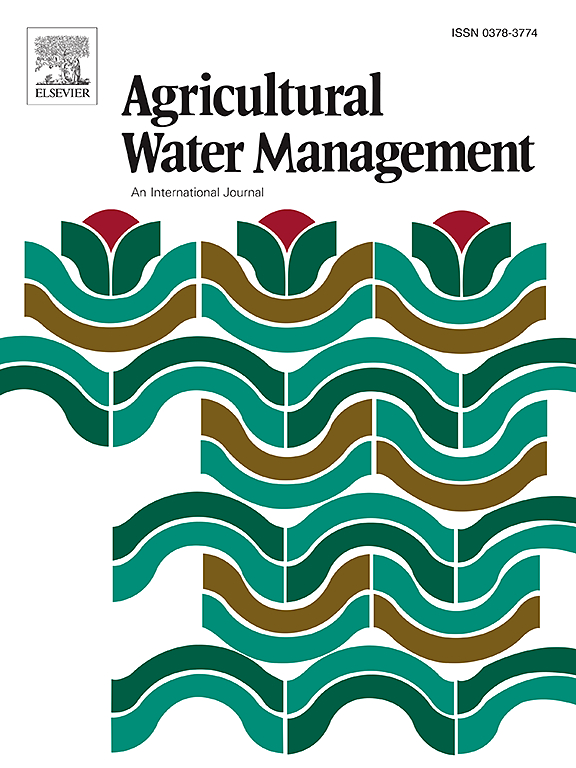融合无人机观测和作物模型模拟用于作物水分胁迫动态估算
IF 5.9
1区 农林科学
Q1 AGRONOMY
引用次数: 0
摘要
利用无人机遥感监测作物水分胁迫(CWS)传统上仅限于经验模型和特定生长阶段,限制了动态的、季节性的评估。本研究提出了一个集成框架,通过基于集成卡尔曼滤波的数据同化(DA),将多光谱无人机观测与SAFYE作物模型相结合,以改进玉米生长模拟,实现连续的CWS监测。基于3年的田间试验,建立了叶片面积指数(LAI)精确反演模型;R2= 0.837, RMSE = 0.397)和地上生物量(AGB;R2 = 0.862, RMSE = 224 g m−2)。利用粒子群算法对模型参数进行标定,并对无人机数据进行同化,优化模拟作物生长和实际蒸散量。结果表明,DA显著提高了模型性能,LAI模拟RMSE从0.29-0.61-0.11-0.36 (NRMSE: 3.57-11.56 %)下降,AGB模拟RMSE从148.2-255.7-49.3-136.8 g m−2 (NRMSE: 5.39-14.27 %)下降,一致性指数(d)超过0.92。ETc行为模拟准确地反映了对灌溉和降雨的响应,在完全灌溉条件下相对误差仅为4.97 % (W4)。建立的作物水分胁迫指数(CWSI)能有效量化不同灌溉处理下的水分胁迫。CWSI减少量与灌水量呈显著负相关,亏水严重程度与CWSI差异峰值出现的时间和幅度呈显著正相关。本研究建立了一个强大的无人机作物模型数据分析框架,用于动态、全季节的CWS诊断和评估。本文章由计算机程序翻译,如有差异,请以英文原文为准。
Assimilating UAV observations and crop model simulations for dynamic estimation of crop water stress
Crop water stress (CWS) monitoring using UAV remote sensing has traditionally been limited to empirical models and specific growth stages, restricting dynamic, season-long assessment. This study proposes an integrated framework combining multispectral UAV observations with the SAFYE crop model via Ensemble Kalman Filter -based data assimilation (DA) to improve maize growth simulation and enable continuous CWS monitoring. Based on three years of field experiments, accurate inversion models for leaf area index (LAI; R2= 0.837, RMSE = 0.397) and aboveground biomass (AGB; R2 = 0.862, RMSE = 224 g m−2) were developed using a random forest algorithm. Model parameters were calibrated using particle swarm optimization, and UAV-derived data were assimilated to optimize simulations of crop growth and actual evapotranspiration (ETc act). Results show that DA significantly enhanced model performance: LAI simulation RMSE decreased from 0.29–0.61–0.11–0.36 (NRMSE: 3.57–11.56 %), AGB simulation RMSE from 148.2–255.7–49.3–136.8 g m−2 (NRMSE: 5.39–14.27 %), and agreement index (d) exceeded 0.92. ETc act simulations accurately reflected responses to irrigation and rainfall, with only 4.97 % relative error under full irrigation (W4). The developed crop water stress index (CWSI) effectively quantified water stress under different irrigation treatments. A significant negative correlation was observed between CWSI reduction and irrigation amount, while the severity of water deficit was positively correlated with the peak value of CWSI differences in terms of both timing and magnitude. This study establishes a robust UAV–crop model DA framework for dynamic, season-long CWS diagnosis and assessment.
求助全文
通过发布文献求助,成功后即可免费获取论文全文。
去求助
来源期刊

Agricultural Water Management
农林科学-农艺学
CiteScore
12.10
自引率
14.90%
发文量
648
审稿时长
4.9 months
期刊介绍:
Agricultural Water Management publishes papers of international significance relating to the science, economics, and policy of agricultural water management. In all cases, manuscripts must address implications and provide insight regarding agricultural water management.
 求助内容:
求助内容: 应助结果提醒方式:
应助结果提醒方式:


